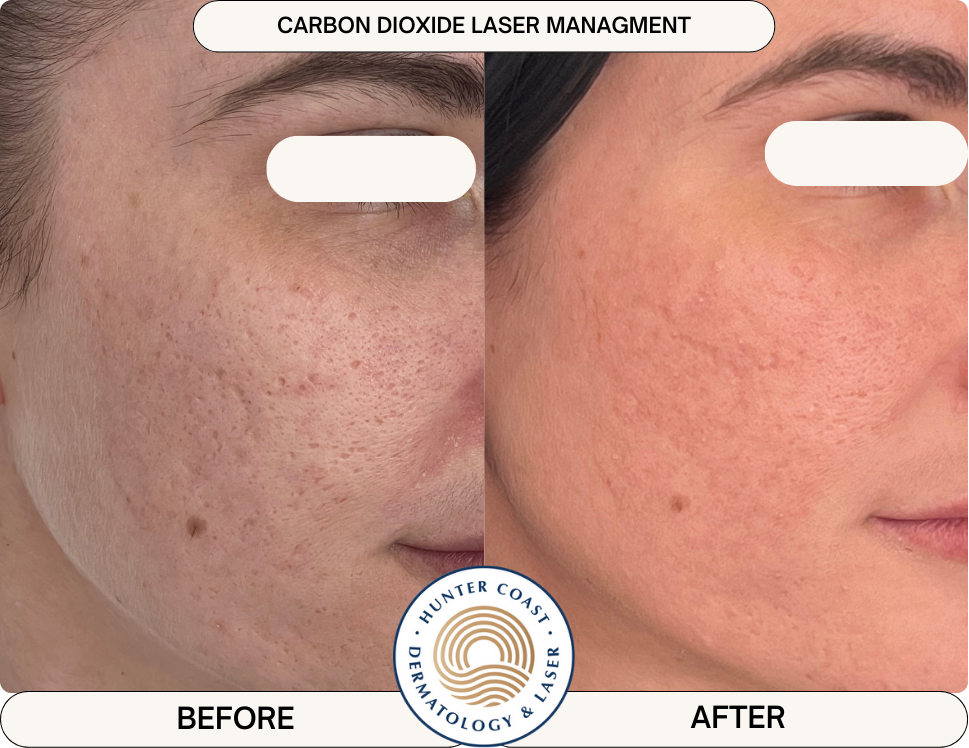
Acne Scarring Treatment
What causes scars?
Scars are permanent colour or texture changes of the skin which occur as a result of injury or inflammation.
Acne scars occur as a result of more persistent or severe pimples. Acne scars are caused by damage that occurs in deeper layers of the skin, which results in indentations (pitting scars) or raised firm lumps (hypertrophic or keloid scarring).
Results After Carbon Dioxide Laser





Our client is receiving a laser resurfacing treatment. This is the most effective way to improve your skin tone and texture without surgery and injectables, while creating a youthful glow.
This procedure effectively treats scarring caused by moderate to severe acne.
What do different scars look like?
There are many different terms used to describe scars. Generally, scars are divided into 3 main categories:
Flat marks – red, purple or brown marks left on the surface of the skin. These are not ‘true’ scars, and can fade slowly over time.
Depressed or indented marks – often referred to as pitting scars or pockmarks.
Raised or lumpy lesions – the medical term for these types of scars is hypertrophic or keloid scars.
Patients can often have a combination of scar types. It is important the type of scarring is properly assessed as the treatment options vary for different scar types .
What are the treatment options for scars?
Scar management will depend on the type, severity and location of the scarring.
At HCDL your dermatologist will examine your skin and tailor treatment to the individual scars as well as your overall skin tone and texture concerns. A combination of different methods may be required to achieve the best outcome. Scar management usually require a course of treatments to achieve the best long term result.
Scar treatment options include:
Medicated or prescription creams – can help with colour changes
Non-ablative lasers, Laser Genesis – these can help reduce red and brown marks and help stimulate collagen production for improved skin tone and texture.
Fractionated ablative lasers – can help both depressed and raised scars, as well as improve skin tone and texture. The result can be greater with these types of lasers, but they have increased recovery time.
Radiofrequency (RF) micro-needling – this is a non-invasive technique and helps scar remodelling, skin tone and texture.
Intralesional steroid injections – injections into the scar itself help to soften and shrink raised, lumpy scars
Injectable fillers – to help fill depressions in the skin
Chemical peels – helpful for milder textural irregularities or used in conjunction with other treatments.
Other acidic treatments such as TCA CROSS
Surgery – subcision, excision and other techniques may be used.
Skin needling – works by breaking down scar tissue and stimulating new collagen. Lasers result in greater stimulation of collagen production and have more effective scar remodelling capabilities, therefore lasers tend to be used over needling for acne scars.
What is the likely outcome of scar treatments?
The goal of treating scars is to improve skin tone, texture and quality, rather than achieving completely blemish-free skin. Outcomes will depend on how severe the scarring was prior to commencing treatment, the type of scarring, and the skin colour of the patient. Some skin types and scars are more responsive to treatment than others.
It is important to have realistic goals and to be patient with your skin. Scar management usually requires a course of treatments to see improvements, and the results are gradual and progress over the treatment course. Your dermatologist will discuss expected outcomes with you.
At home scar management
Post-operative scars may be improved by measures such as diligent post-operative wound care, avoiding infection, silicone gels or tapes and gentle massage. Minimising alcohol consumption and avoiding smoking are also important factors in wound healing.
Speak to your dermatologist to discuss the best treatment options for you.

